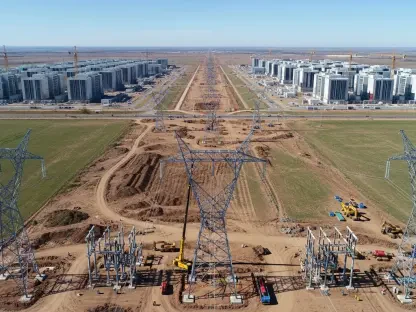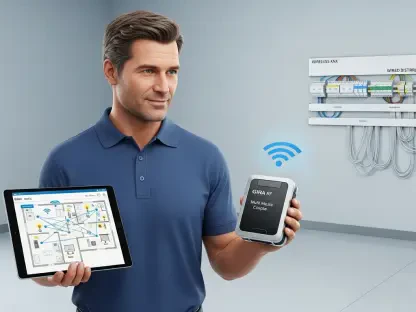Efforts to enhance urban 5G connectivity have been ongoing, and recent developments in utilizing W-band frequencies for this purpose are showing significant promise. Ericsson and Drei Austria’s collaboration aims to demonstrate the effectiveness of microwave links in high-frequency bands within densely populated areas. This initiative could potentially bring advanced technological solutions to urban settings.
A recent field trial using W-band microwave technology indicated its potential as a high-capacity backhaul solution, especially in areas where existing E-band networks face congestion.
Advancements in High-Frequency Backhaul Solutions
Potential of W-Band Technology in Urban Environments
The recent field trial demonstrated the W-band’s capability in addressing spectrum congestion and enhancing connectivity. This improvement is particularly significant in dense urban areas where conventional E-band networks often struggle with congestion. The W-band operates between 92 and 115 GHz, providing a new spectrum that complements the E-band and can significantly improve network performance.
The trial used Ericsson’s prototype W-band microwave equipment on Drei’s commercial network, effectively delivering ultra-high-speed wireless communication despite real-world challenges like heavy rain. This capability is crucial for maintaining reliable internet speeds, reducing gaming latency, and offering faster downloads and uploads, ultimately benefiting end users. With the growing data demands in cities, this advancement in high-frequency backhaul solutions can pave the way for emerging applications such as IoT devices critical for smart homes.
Enhancing Reliability and Capacity in Urban Networks
Wenceslao Garcia de Otazo, head of transmission at Drei, emphasized the accuracy of field data collected during the trial, which confirmed the viability of W-band microwave links as a reliable, high-capacity solution for connecting 4G/5G sites, even under adverse weather conditions. This heightened reliability is imperative in urban settings, where connectivity disruptions can have far-reaching impacts.
Mikael Öhberg, head of microwave systems at Ericsson, highlighted W-band technology’s potential to help service providers enhance microwave networks and manage urban network congestion. This is particularly relevant when E-band networks fall short in providing the necessary capacity. By integrating W-band technology, service providers can offer enhanced customer experiences, ensuring that urban areas remain well-connected even as data consumption continues to surge.
Future Implications and Continued Advancements
Supporting Emerging Applications and Technologies
The increased bandwidth capacity of W-band technology is expected to support a range of emerging applications. With the proliferation of IoT devices and the growing complexity of smart home systems, the demand for robust and high-capacity networks is more pressing than ever. W-band frequencies offer a solution that not only meets current demands but also anticipates future needs, ensuring that urban infrastructures remain ahead of the curve.
This trial reflects a commitment to innovation and the pursuit of excellence in digital connectivity. By continually pushing the boundaries of technology, Ericsson and Drei are setting the stage for a new era of urban 5G performance. The successful implementation of W-band technology in real-world conditions underscores its potential as a cornerstone of next-generation network solutions.
Moving Towards Next-Generation Network Solutions
The collaboration between Ericsson and Drei signifies a significant step towards next-generation network solutions. This partnership is not just about addressing current connectivity issues but also about anticipating future challenges and requirements. By leveraging W-band technology, these companies are spearheading the evolution of digital infrastructure, ensuring that urban areas can handle the increasing load of data traffic.
The trial’s positive results demonstrate that W-band microwave technology is not only a viable solution for today’s connectivity challenges but also a strategic investment in the future of urban connectivity. As digital demands continue to grow, innovations like W-band technology will be crucial in maintaining high standards of service and ensuring that networks remain resilient and efficient.
A Step Forward in Urban Connectivity
Efforts to enhance urban 5G connectivity have been continuous, and recent advancements in utilizing W-band frequencies for this purpose are showing substantial promise. Collaborative work between Ericsson and Drei Austria aims to illustrate the efficiency of microwave links in high-frequency bands within densely populated urban areas. This initiative carries the potential to introduce cutting-edge technological solutions to city environments.
A noteworthy field trial employing W-band microwave technology highlighted its potential as a high-capacity backhaul solution, particularly in areas where existing E-band networks are experiencing congestion. This technology leverages the higher frequency range, thus alleviating some of the pressure from lower bands and boosting overall network performance. The introduction of these next-generation microwave links could revolutionize urban connectivity by providing more robust and reliable data transmission. If these trials continue to show positive results, we could witness a significant shift in how urban networks are structured and how they handle vast amounts of data traffic in the future.









